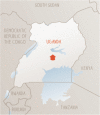Demographics, clinical characteristics and neonatal outcomes in a rural Ugandan NICU
- PMID: 25234069
- PMCID: PMC4174605
- DOI: 10.1186/1471-2393-14-327
Demographics, clinical characteristics and neonatal outcomes in a rural Ugandan NICU
Abstract
Background: Ninety-six percent of the world's 3 million neonatal deaths occur in developing countries where the majority of births occur outside of a facility. Community-based approaches to the identification and management of neonatal illness have reduced neonatal mortality over the last decade. To further expand life-saving services, improvements in access to quality facility-based neonatal care are required. Evaluation of rural neonatal intensive care unit referral centers provides opportunities to further understand determinants of neonatal mortality in developing countries. Our objective was to describe demographics, clinical characteristics and outcomes from a rural neonatal intensive care unit (NICU) in central Uganda from 2005-2008.
Methods: The NICU at Kiwoko hospital serves as a referral center for three rural districts of central Uganda. For this cross sectional study we utilized a NICU clinical database that included admission information, demographics, and variables related to hospital course and discharge. Descriptive statistics are reported for all neonates (<28 days old) admitted to the NICU between December 2005 and September 2008, disaggregated by place of birth. Percentages reported are among neonates for which data on that indicator were available.
Results: There were 809 neonates admitted during the study period, 68% (490/717) of whom were inborn. The most common admission diagnoses were infection (30%, 208/699), prematurity (30%, 206/699), respiratory distress (28%, 198/699) and asphyxia (22%, 154/699). Survival to discharge was 78% (578/745). Mortality was inversely proportional to birthweight and gestational age (P-value test for trend <0.01). This was true for both inborn and outborn infants (p < 0.01). Outborn infants were more likely to be preterm (44%, (86/192) vs. 33%, (130/400), P-value <0.01) and to be low birthweight (58%, (101/173) vs. 40%, (190/479), P-value <0.01) than inborn infants. Outborn neonates had almost twice the mortality (33%, 68/208) as inborn neonates (17%, 77/456) (P-value <0.01).
Conclusions: Understanding determinants of neonatal survival in facilities is important for targeting improvements in facility based neonatal care and increasing survival in low and middle income countries.
Figures



References
-
- UNICEF, WHO, The World Bank, UN DESA/Population Division . Levels and Trends in Child Mortality—Report 2002. 2012.
-
- United Nations, General Assembly: United Nations Millennium Declaration. A/RES/55/2 (18 September 2000), available from http://www.un.org/millennium/declaration/ares552e.pdf
-
- Lawn JE, Kinney MV, Black RE, Pitt C, Cousens S, Kerber K, Corbett E, Moran AC, Morrissey CS, Oestergaard MZ. Newborn survival: a multi-country analysis of a decade of change. Health Policy Plan. 2012;27 Suppl 3:iii6–iii28. - PubMed
Pre-publication history
-
- The pre-publication history for this paper can be accessed here:http://www.biomedcentral.com/1471-2393/14/327/prepub
Publication types
MeSH terms
LinkOut - more resources
Full Text Sources
Other Literature Sources
Medical

